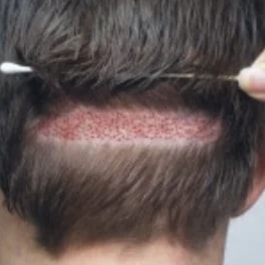Follicular Unit Extraction (FUE)
Home/Hair Restoration & Transplant Surgery/Follicular Unit Extraction (FUE)
What is Follicular Unit Extraction (FUE)?
Follicular Unit Extraction (FUE) is a relatively new hair loss surgery technique that involves individual removal of follicular units from the donor site. The technique is essentially a process in which a 0.8 – 1.0 mm round donor harvest tool is used to individually extract entire intact follicular units, which regulate hair growth. From there, the follicles are transplanted into the balding area of the scalp, eyebrows, beard, or elsewhere on the body.
Our plastic surgeon, Carrie Houssock, MD, FACS, offers this surgical option as an updated alternative to the traditional strip harvest method, which involves the removal and redistribution of hair from a single donor site on the back of the head. When performed by a qualified surgeon, both FUE and the strip harvest method can be excellent options and provide natural-looking and long-lasting effects. Read on for more information about FUE, and feel free to schedule a consultation with Dr. Houssock to determine the best hair restoration treatment for your needs.



 Before Procedure
Before Procedure During Procedure
During Procedure 2 Weeks After Procedure
2 Weeks After Procedure Day of Procedure
Day of Procedure Day of Procedure
Day of Procedure 2 Weeks After
2 Weeks After Day of Procedure
Day of Procedure Day of Procedure
Day of Procedure 2 Weeks After
2 Weeks After